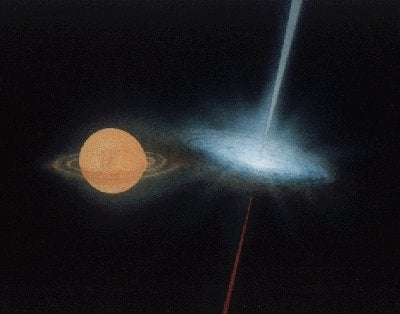The recent discovery of a neutron star exhibiting behavior previously believed to be exclusive to black holes is challenging astronomers’ understanding of the nature of some of the most extreme phenomena in the cosmos.
An international team of astronomers from the Netherlands, United Kingdom, and Australia used the Australia Telescope to study binary star system Circinus X-1 in radio waves during the past three years. Circinus X-1 consists of a star 3 to 5 times the mass of the Sun in a close orbital dance with a neutron star companion. The star system lies about 20,000 light-years away from Earth in our Milky Way Galaxy.
Since the 1970s, observers have noted Circinus X-1’s emission of radio waves. Now, the team of astronomers, led by Rob Fender of the University of Amsterdam, has peered into the depths of the radio cloud and found something astonishing. Jets of matter are ejected out of the star system at 99.8 percent the speed of light.
These jets are the fastest ever observed shooting out of something other than a supermassive black hole in the center of a distant galaxy, and the fastest outflow ever observed originating within our own Milky Way.
The two stars circle each other once every 16.6 days, drawing tauntingly closer, then moving farther apart. As they dance, the neutron star — the end product of the violent explosion and collapse of a giant star — steals matter away from its stellar companion, forming an ever-growing accretion disk of hot gas in its outer atmosphere.
It seems that when the two stars get closest to one another, roughly every 17 days, hot matter from the accretion disk is spewed violently into interstellar space. The observation raises the question: What creates these enormously fast jets?
Astronomers previously attributed such speeding torrents to the environment characteristic of black holes, where space-time is warped beyond repair and gravity becomes infinitely potent. But if a neutron star can produce the same ultra-relativistic eruptions, then some more general set of circumstances must exist that accelerates matter to breakneck speeds.
“Whatever the physics underlying the production of ultra-relativistic jets — which are related to the jets of distant, massive galaxies and also probably gamma-ray bursts — it must be connected to the things that neutron stars and black holes have in common,” says Fender.
He points to high densities, high pressures, and the build-up of magnetic fields as mutual characteristics and potential clues.
The observation is forcing astronomers to rethink their definitions of black holes and neutron stars, and to come to grips with the mechanism behind high-speed jets. It is at these most extreme conditions — where gravity contorts space and slows time — that fundamental physics comes to light.
Understanding the cause of these jets, then, is crucial.
“They are the fastest moving phenomena in the universe and probably are responsible for, or at least associated with, the biggest explosions since the Big Bang,” Fender says.
That’s why the team plans to continue studying Circinus X-1, to home in on the details.
“Since the outbursts go off every 16.6 days,” explains Fender, “we can uniquely time the observations from ground and space-based facilities to observe at the moment of jet formation, and to study the physics more closely. This year, we will continue to make radio observations and hope to have long observations with the European Integral orbiting gamma-ray observatory.”










